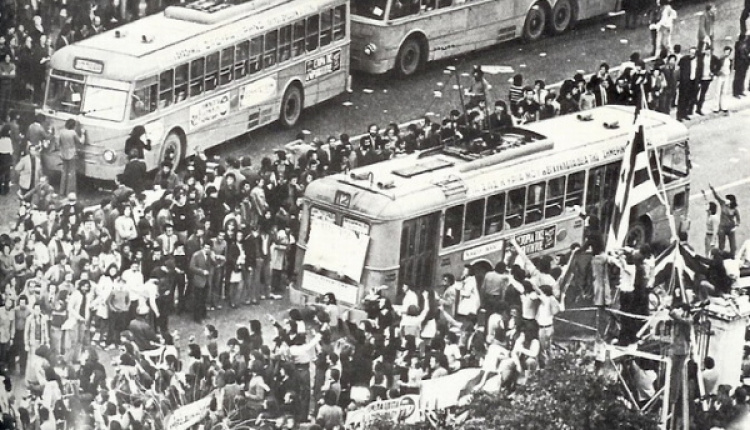November 17, 1973: Athens Polytechnic Uprising
- by XpatAthens
- Friday, 17 November 2023

The Athens Polytechnic Uprising in 1973 was a massive demonstration of the popular rejection of the Greek military junta of 1967–1974. The uprising began on November 14, 1973, escalated to an open anti-junta revolt, and ended in bloodshed in the early morning of November 17 after a series of events starting with a tank crashing through the gates of the Polytechnic.
What Happened In History
Since April 21, 1967, Greece had been under the dictatorial rule of the military, a regime that abolished civil rights, dissolved political parties, and exiled, imprisoned and tortured politicians and citizens based on their political beliefs.
The junta, trying to control every aspect of politics, had interfered with student syndicalism since 1967, by banning student elections in universities, forcibly drafting students, and imposing non-elected student union leaders in the national student's union. These actions eventually created anti-junta sentiments among students, such as geology student Kostas Georgakis who committed suicide in 1970 in Genoa, Italy as an act of protest against the junta. With that exception, the first massive public action against the junta came from students on February 21, 1973.
On February 21, 1973, law students went on strike and barricaded themselves inside the buildings of the Law School of the University of Athens in the centre of Athens, demanding repeal of the law that imposed forcible drafting of "subversive youths", as 88 of their peers had been forcibly drafted. The police were ordered to intervene and many students were reportedly subjected to police brutality. The events at the Law School are often cited as the prelude to the Polytechnic uprising.
On November 14th of 1973 students gather at the Athens Polytechnic to demonstrate against the Junta. This demonstration which is coordinated with occupations of campuses in Patras and Thessaloniki turns into a student rebellion that gathers strength every day as more and more people join. On the 16th, the students and fellow demonstrators attempt to march from the Polytechnic to Syntagma square but they are halted by the police.
As more people gather at the Polytechnic, there are already plans for ending the student rebellion, using tanks from the nearby bases in and around Athens. The students are preparing for a siege, collecting food and medical supplies, building barricades, and broadcasting on a clandestine radio station that the time is right to overthrow the junta and calling for their countrymen to join them in central Athens. Anti-Junta and anti-American graffiti are painted on buildings and passing buses which spread their message throughout the city.
At 2 am on November 17th, tanks are ordered to crush the student rebellion at the Polytechnic. At 2:15 a group of students comes out to negotiate a surrender asking for half an hour to evacuate the campus. The officers in charge will only give them fifteen minutes but don't even wait for ten. At 3 am a tank crashes through the gate of the polytechnic and police and military storm the campus. As the gate crashes to the ground students rush out to escape and are beaten with clubs and arrested. At least 34 demonstrators are killed though there are rumors that the number is much higher. Several hundred are injured and almost a thousand are detained at the school and at the Ministry of Public Order which had been under siege by demonstrators.
For the next two days, crowds attempting to gather in central Athens are broken up by police and soldiers who are everywhere. Tanks are parked in squares around the city and surround the Parliament building. The rebellion at the Polytechnic is over and the country is put under martial law for the next week. Groups larger than four people are not permitted to gather and there is a curfew between 7 pm and 5 am.
How This Day Is Commemorated In Greece
November 17 is observed as a holiday in Greece for all educational establishments. Commemorative services are held and students attend school only for these, while some schools and all universities stay closed on this day. The central location for the commemoration is the campus of the Polytechneio. The campus is closed on the 15th (the day the students first occupied the campus in 1973). The commemoration day ends traditionally with a demonstration that begins from the campus of the Polytechneio and ends at the United States embassy.
Practical Information About This Day
Police security is always on high alert on November 17th. Commemorative demonstrations are observed and thus the streets of central Athens are closed - it is recommended that drivers avoid central Athens on this day. Public transportation (buses, trains, trams) in central Athens is also typically affected by the demonstrations.



